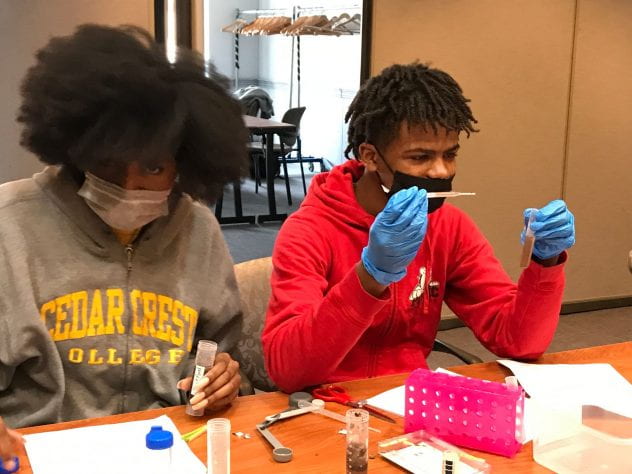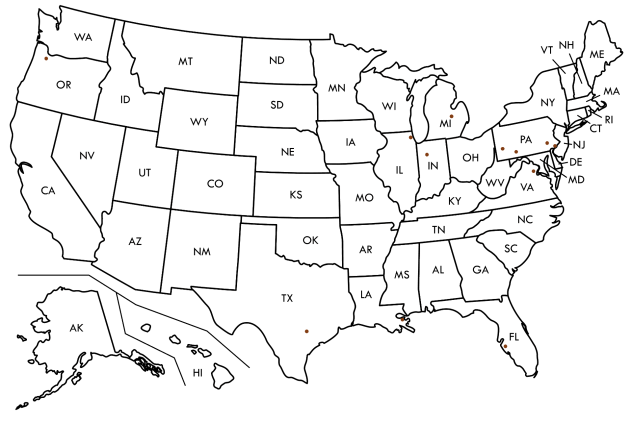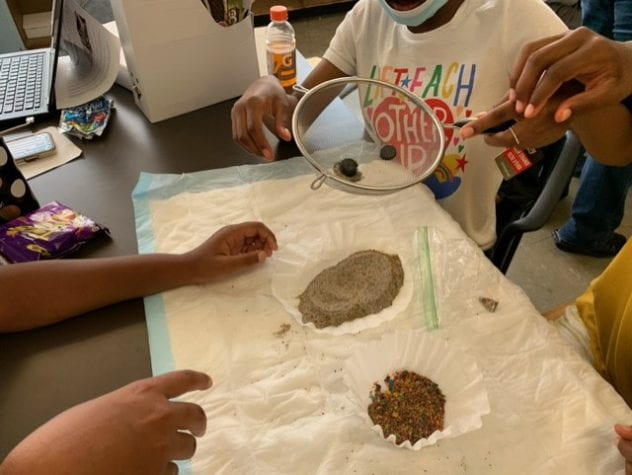K-12 Experiment Kits
Hidden Treasures!
The most recent K-12 experiments are centered around learning what is located inside our soil, from nitrogen, potassium, and phosphorus needed for plant growth to lead and cadmium which is toxic, and of course, the hidden treasures of critical metals!

Some results from our tests:

| ppm | Portland, OR | Pittsburgh, PA | Evanston, IL | Austin, TX | New Orleans, LA | Tampa, FL | Philadelphia, PA | Flint, MI | West Lafayette, IN |
| As | 4.66 | 19.5 | 11.06 | 2.85 | 1.84 | 0.454 | 5.79 | 3.43 | 5.91 |
| Cd | 0.47 | 0.973 | 1.47 | 0.249 | 0.186 | 0.138 | 0.305 | 0.199 | 0.654 |
| Co | 17.47 | 18.7 | 10.62 | 5.57 | 4.81 | 0.447 | 9.15 | 5.27 | 11.7 |
| K | 1870.00 | 1670 | 1580.00 | 1910 | 475.5 | 92.4 | 984 | 500 | 1330 |
| Ni | 16.67 | 44.7 | 17.93 | 8.57 | 8.92 | 1.14 | 14.8 | 11.5 | 23.6 |
| P | 1260.33 | 552 | 874.33 | 541 | 244 | 449 | 609 | 279 | 1480 |
| Pb | 22.32 | 34.4 | 173.93 | 15.1 | 8.67 | 4.22 | 63.9 | 8.37 | 25.8 |
Values in ppm for Miracle Gro Seed Started control soil are:
As 0.37
Cd 0.0829
Co 623
K 751
Ni 1.1
P 398
Pb 4.2
Written instructions for the experiment
Necessary items for kit (if not provided)
Links to Learning Videos
Grade 3-5 Hidden Treasures Lesson and Demo Video
Grade 6-8 Hidden Treasures Lesson and Demo Video
Grade 9-10 Hidden Treasures Lesson and Demo Video
Grade 11-12 Hidden Treasures Lesson and Demo Video
Links to Assessments
Grade 3-5 Hidden Treasures Assessment
Grade 6-8 Hidden Treasures Assessment
Grade 9-10 Hidden Treasures Assessment
Grade 11-12 Hidden Treasures Assessment
Send samples for quantitative analysis to:
Attn: Dr Marta Guron and Prof. Eric Schelter, University of Pennsylvania, Department of Chemistry, 250 S 33rd St, Philadelphia, PA 19104. Be sure to enclose your sample, together with the form provided (last page of this document), so we can give you your results after quantitative analysis of the nutrients necessary for plant growth, hazardous metals, and the hidden treasures – a sampling of the critical metals. Please be advised this may take a few months from the time you send your sample. Special thanks to Galbraith Laboratories for their support of this analysis!

Separations!

The CSSM has created an experiment kit “recipe” intended to introduce K-12 students, informally, to separations science in a safe, hands-on way. For older students (grades 6-12), there is a component associated with social justice, as well. All experiment write-ups, videos and assessments are FREE and leveled specifically for children in grades K-2, 3-5, 6-8, 9-10 and 11-12!
Learning Objectives
Elementary School (K-5) Learning Objectives
Middle School (6-8) Learning Objectives
High School (9-12) Learning Objectives
Mix Recipe (costs less than $1 a set)
The mix recipe (this makes 3 sets, and all quantities are approximate):
- 1 cup Fruity Pebbles
- food coloring
- red: about 6 drops
- yellow: about 6 drops
- green: about 4 drops
- blue: about 4 drops
Puree the first items in a blender. Be sure to use a blender NOT designated for lab use.
To the above, add:
- 1/4 t (or ~9g) iron filings
- 1-3 T (or ~22-66 g) gravel
- ~1/8 cup (or ~33 g) white craft sand (play sand ought to work, too)
Place the mixture in a sandwich bag.
Each kit, additionally, needs the materials necessary for the separation. Those materials are:
- A sieve or sifter
- A magnet
- 4 coffee filters
- 1-2 toothpicks
- 2 plastic cups
- Spoon
Place the sandwich bag full of the mixture, as well as the items needed to complete the separation in the larger (gallon) zipper bag.
For a simpler recipe suitable for STEAM nights or science experiment tables at community events, leave out the sand and food coloring and encourage children to separate via size (with sieve), magnetism (with magnets), and solubility (by adding water forming a colored solution).
Links to Learning Videos
Links to Grade-Level Specific Assessments (If you’d like to be added as an editor for your own assessment for viewing of results or modifications of the questions, please email guron@sas.upenn.edu.)
If you have tried these experiments with children, don’t forget to tweet @NSF_CSSM with the #CSSMSustainabilityAmbassador with photos and tell us how you and the kids are helping to protect the earth! If your school/organization is not on twitter, please send us photos (ensuring appropriate permissions have been obtained), so we may share on our twitter page.
National Chemistry Week 2019
CSSM members from Prof. Suzanne Bart’s lab participated in National Chemistry Week in West Lafayette, IN, an event sponsored annually by the American Chemical Society. This event is a “public awareness campaign that promotes the value of chemistry in everyday life.” This event is held in classrooms all over the United States, and facilitates interactions of ACS members with K-12 students.

Students and their teacher work with Rare Earth magnets to make a paper clip chain. In this module, students learned about the magnetic properties of metals, and how they can induce magnetic fields in non-magnetic materials. This is important given the potential use of magnetic properties in developing separations strategies.
If you are interested in learning more information about CSSM public outreach efforts and opportunities, please contact guron@sas.upenn.edu.
